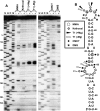Tombusvirus recruitment of host translational machinery via the 3' UTR
- PMID: 20507975
- PMCID: PMC2885689
- DOI: 10.1261/rna.2135210
Tombusvirus recruitment of host translational machinery via the 3' UTR
Abstract
RNA viruses recruit the host translational machinery by different mechanisms that depend partly on the structure of their genomes. In this regard, the plus-strand RNA genomes of several different pathogenic plant viruses do not contain traditional translation-stimulating elements, i.e., a 5'-cap structure and a 3'-poly(A) tail, and instead rely on a 3'-cap-independent translational enhancer (3'CITE) located in their 3' untranslated regions (UTRs) for efficient synthesis of viral proteins. We investigated the structure and function of the I-shaped class of 3'CITE in tombusviruses--also present in aureusviruses and carmoviruses--using biochemical and molecular approaches and we determined that it adopts a complex higher-order RNA structure that facilitates translation by binding simultaneously to both eukaryotic initiation factor (eIF) 4F and the 5' UTR of the viral genome. The specificity of 3'CITE binding to eIF4F is mediated, at least in part, through a direct interaction with its eIF4E subunit, whereas its association with the viral 5' UTR relies on complementary RNA-RNA base-pairing. We show for the first time that this tripartite 5' UTR/3'CITE/eIF4F complex forms in vitro in a translationally relevant environment and is required for recruitment of ribosomes to the 5' end of the viral RNA genome by a mechanism that shares some fundamental features with cap-dependent translation. Notably, our results demonstrate that the 3'CITE facilitates the initiation step of translation and validate a molecular model that has been proposed to explain how several different classes of 3'CITE function. Moreover, the virus-host interplay defined in this study provides insights into natural host resistance mechanisms that have been linked to 3'CITE activity.
Figures













Similar articles
-
Tombusvirus Y-shaped translational enhancer forms a complex with eIF4F and can be functionally replaced by heterologous translational enhancers.J Virol. 2013 Feb;87(3):1872-83. doi: 10.1128/JVI.02711-12. Epub 2012 Nov 28. J Virol. 2013. PMID: 23192876 Free PMC article.
-
Context-influenced cap-independent translation of Tombusvirus mRNAs in vitro.Virology. 2008 Oct 25;380(2):203-12. doi: 10.1016/j.virol.2008.08.003. Epub 2008 Sep 4. Virology. 2008. PMID: 18775547
-
Poly(A)-binding protein facilitates translation of an uncapped/nonpolyadenylated viral RNA by binding to the 3' untranslated region.J Virol. 2012 Aug;86(15):7836-49. doi: 10.1128/JVI.00538-12. Epub 2012 May 16. J Virol. 2012. PMID: 22593149 Free PMC article.
-
3' Cap-independent translation enhancers of positive-strand RNA plant viruses.Curr Opin Virol. 2011 Nov;1(5):373-80. doi: 10.1016/j.coviro.2011.10.002. Epub 2011 Oct 24. Curr Opin Virol. 2011. PMID: 22440838 Review.
-
3'UTRs of carmoviruses.Virus Res. 2015 Aug 3;206:27-36. doi: 10.1016/j.virusres.2015.01.023. Epub 2015 Feb 4. Virus Res. 2015. PMID: 25662021 Review.
Cited by
-
Global organization of a positive-strand RNA virus genome.PLoS Pathog. 2013;9(5):e1003363. doi: 10.1371/journal.ppat.1003363. Epub 2013 May 23. PLoS Pathog. 2013. PMID: 23717202 Free PMC article.
-
Analysis of the interacting partners eIF4F and 3'-CITE required for Melon necrotic spot virus cap-independent translation.Mol Plant Pathol. 2017 Jun;18(5):635-648. doi: 10.1111/mpp.12422. Epub 2016 Jul 27. Mol Plant Pathol. 2017. PMID: 27145354 Free PMC article.
-
Efficient translation of Eggplant mottled dwarf nucleorhabdovirus N and X genes requires both 5' and 3' UTRs.Virol J. 2021 Jun 26;18(1):129. doi: 10.1186/s12985-021-01601-4. Virol J. 2021. PMID: 34174907 Free PMC article.
-
Non-canonical Translation in Plant RNA Viruses.Front Plant Sci. 2017 Apr 6;8:494. doi: 10.3389/fpls.2017.00494. eCollection 2017. Front Plant Sci. 2017. PMID: 28428795 Free PMC article. Review.
-
Tombusvirus Y-shaped translational enhancer forms a complex with eIF4F and can be functionally replaced by heterologous translational enhancers.J Virol. 2013 Feb;87(3):1872-83. doi: 10.1128/JVI.02711-12. Epub 2012 Nov 28. J Virol. 2013. PMID: 23192876 Free PMC article.
References
-
- Batten JS, Desvoyes B, Yamamura Y, Scholthof KB 2006. A translational enhancer element on the 3′-proximal end of the Panicum mosaic virus genome. FEBS Lett 580: 2591–2597 - PubMed
-
- Belsham GJ 2009. Divergent picornavirus IRES elements. Virus Res 139: 183–192 - PubMed
-
- Browning KS 1996. The plant translational apparatus. Plant Mol Biol 32: 107–144 - PubMed
-
- Browning KS, Humphreys J, Hobbs W, Smith GB, Ravel JM 1990. Determination of the amounts of the protein synthesis initiation and elongation factors in wheat germ. J Biol Chem 265: 17967–17973 - PubMed
-
- Browning KS, Webster C, Roberts JK, Ravel JM 1992. Identification of an isozyme form of protein synthesis initiation factor 4F in plants. J Biol Chem 267: 10096–10100 - PubMed
Publication types
MeSH terms
Substances
LinkOut - more resources
Full Text Sources
Other Literature Sources
Miscellaneous
